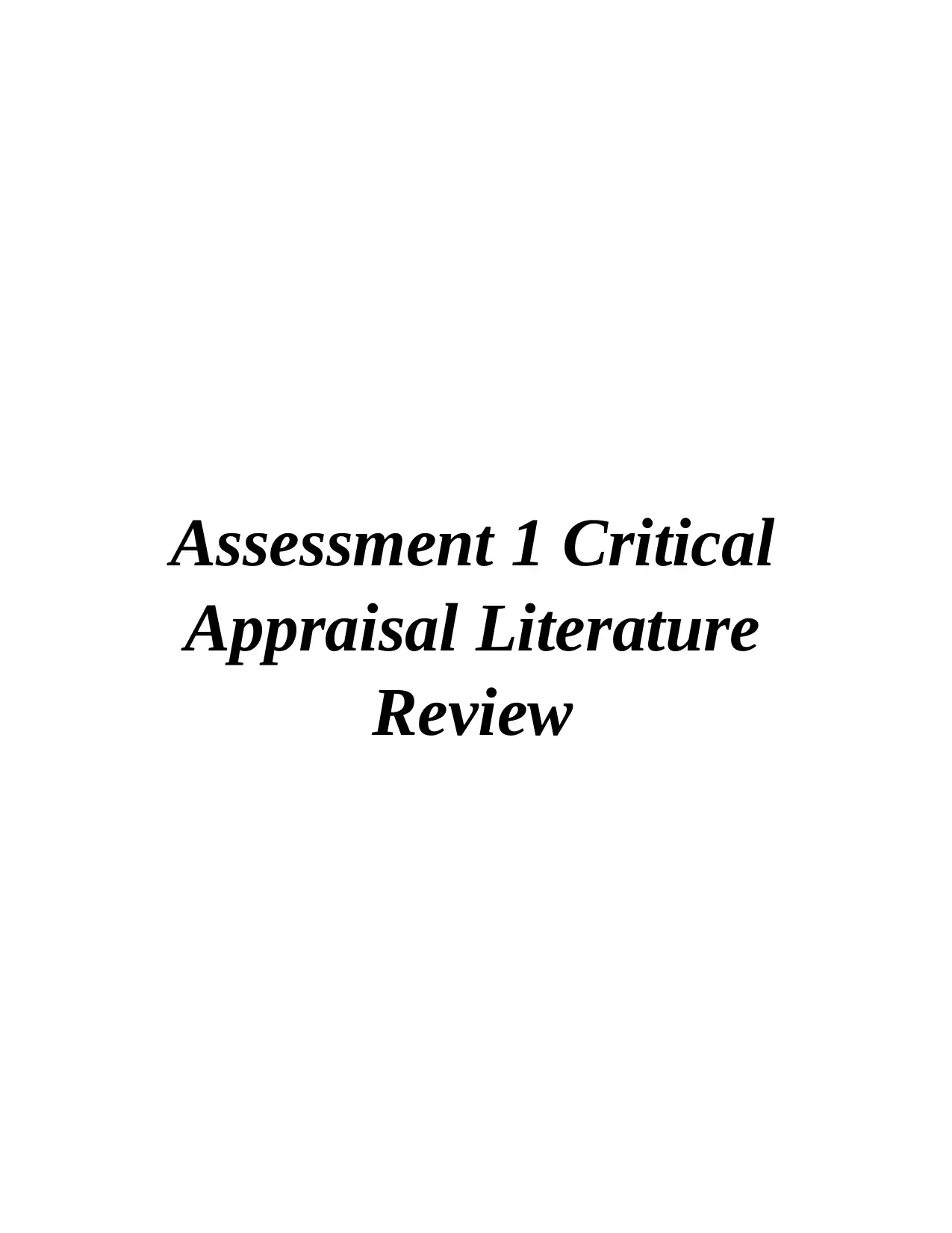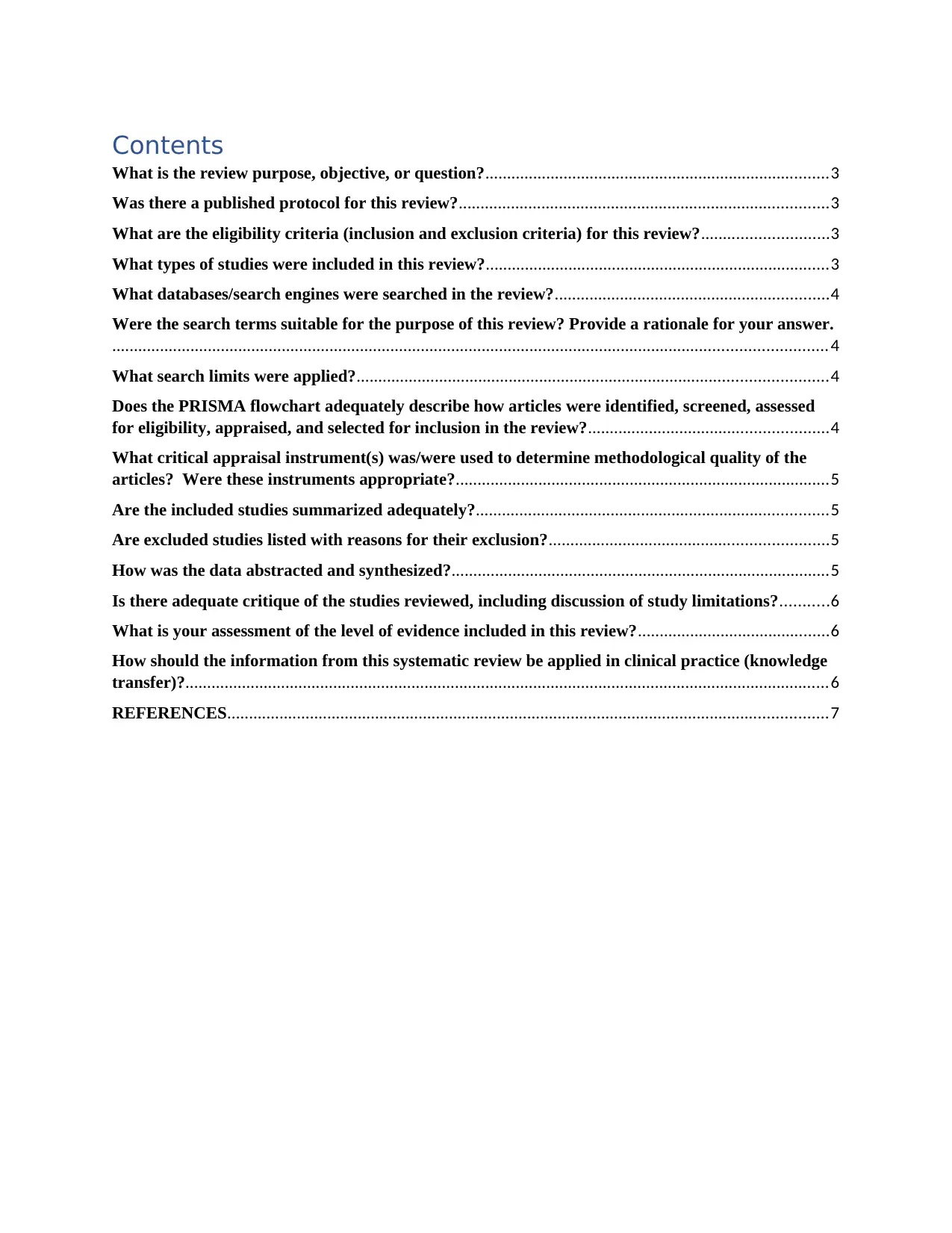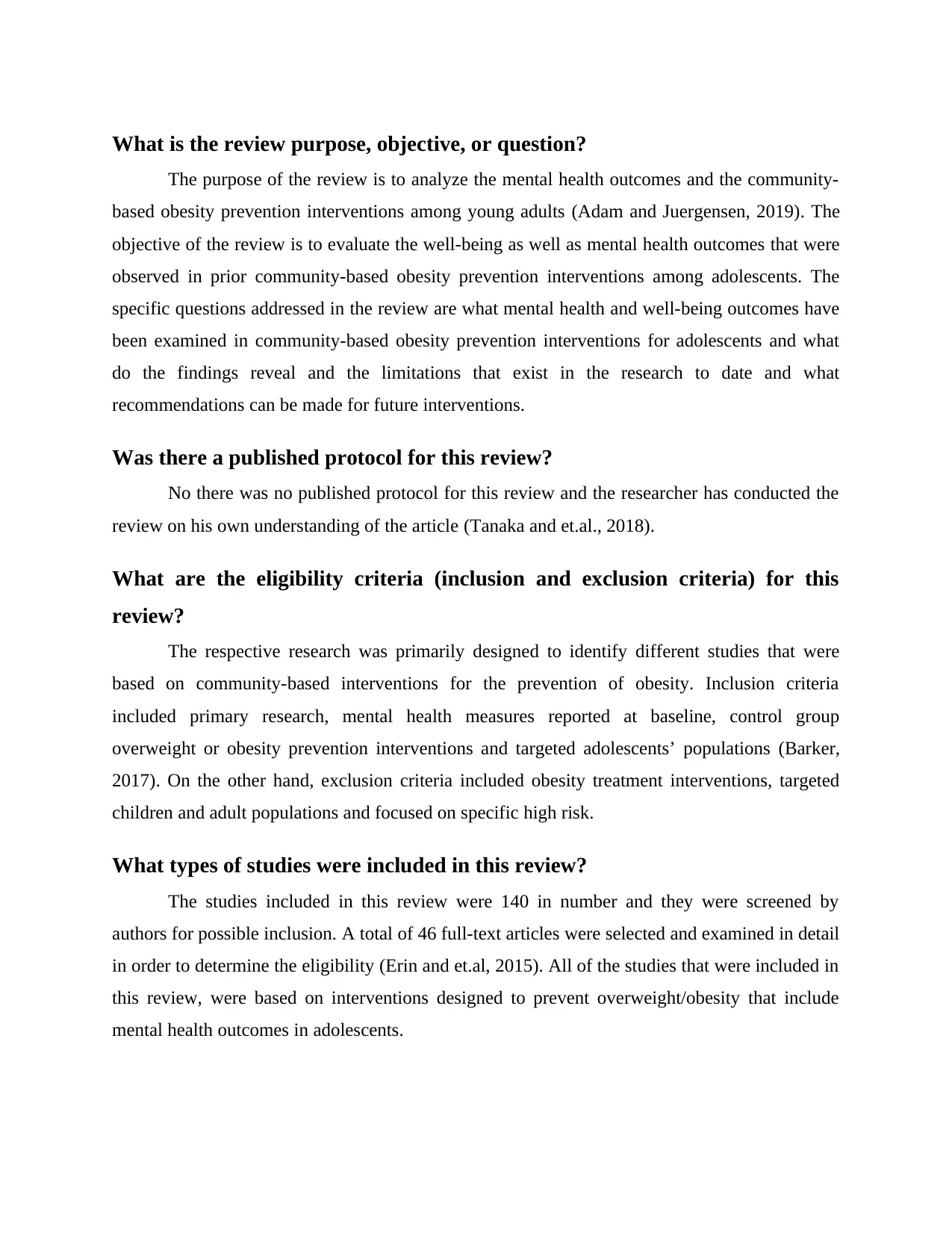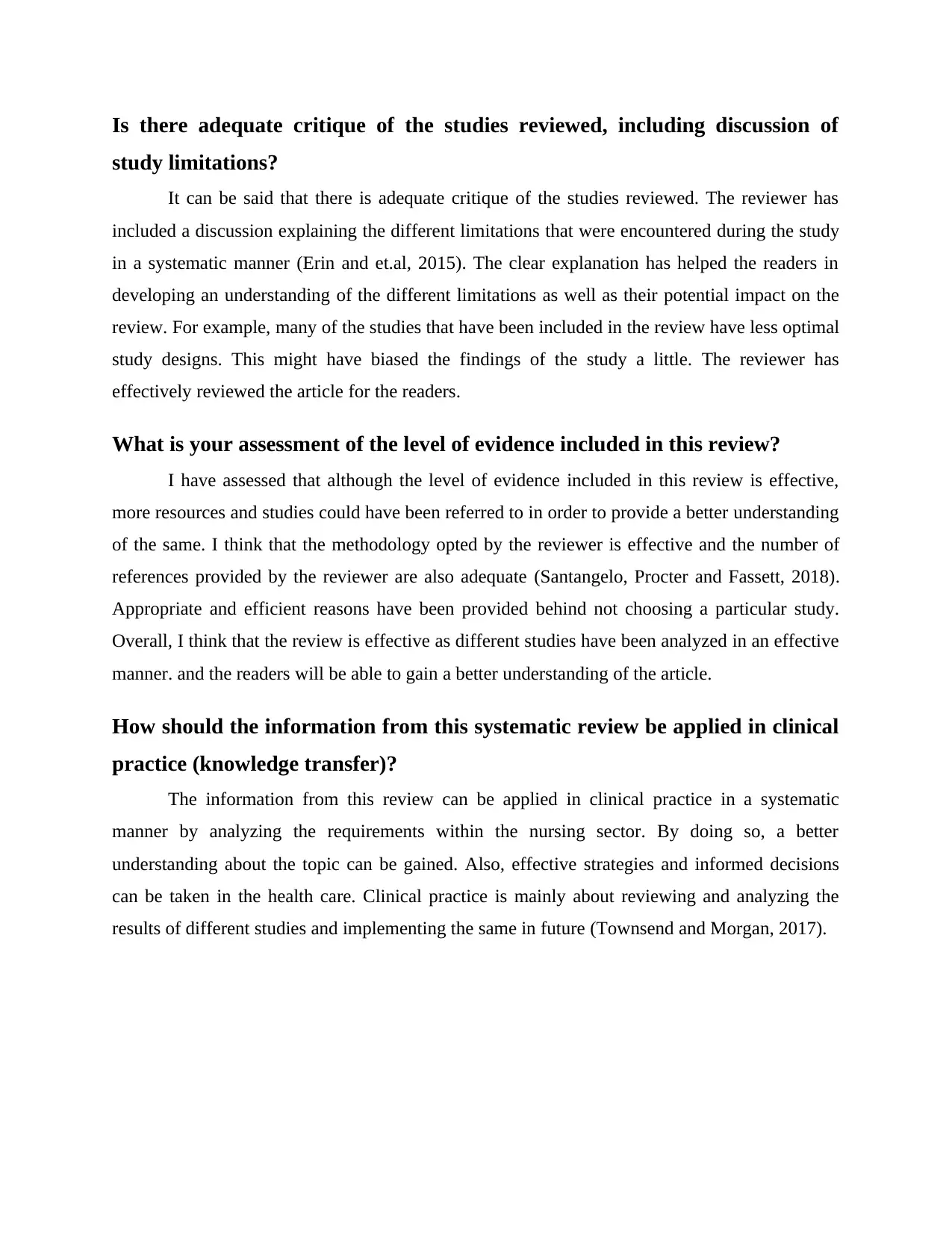Assessment 1 Critical Appraisal Literature Review
VerifiedAdded on 2022/12/27
|7
|1971
|390
AI Summary
This review analyzes the mental health outcomes and community-based obesity prevention interventions among young adults. It evaluates the well-being and mental health outcomes observed in prior interventions and provides recommendations for future interventions.
Contribute Materials
Your contribution can guide someone’s learning journey. Share your
documents today.

Assessment 1 Critical
Appraisal Literature
Review
Appraisal Literature
Review
Secure Best Marks with AI Grader
Need help grading? Try our AI Grader for instant feedback on your assignments.

Contents
What is the review purpose, objective, or question?...............................................................................3
Was there a published protocol for this review?.....................................................................................3
What are the eligibility criteria (inclusion and exclusion criteria) for this review?.............................3
What types of studies were included in this review?...............................................................................3
What databases/search engines were searched in the review?...............................................................4
Were the search terms suitable for the purpose of this review? Provide a rationale for your answer.
.................................................................................................................................................................... 4
What search limits were applied?............................................................................................................4
Does the PRISMA flowchart adequately describe how articles were identified, screened, assessed
for eligibility, appraised, and selected for inclusion in the review?.......................................................4
What critical appraisal instrument(s) was/were used to determine methodological quality of the
articles? Were these instruments appropriate?......................................................................................5
Are the included studies summarized adequately?.................................................................................5
Are excluded studies listed with reasons for their exclusion?................................................................5
How was the data abstracted and synthesized?.......................................................................................5
Is there adequate critique of the studies reviewed, including discussion of study limitations?...........6
What is your assessment of the level of evidence included in this review?............................................6
How should the information from this systematic review be applied in clinical practice (knowledge
transfer)?....................................................................................................................................................6
REFERENCES..........................................................................................................................................7
What is the review purpose, objective, or question?...............................................................................3
Was there a published protocol for this review?.....................................................................................3
What are the eligibility criteria (inclusion and exclusion criteria) for this review?.............................3
What types of studies were included in this review?...............................................................................3
What databases/search engines were searched in the review?...............................................................4
Were the search terms suitable for the purpose of this review? Provide a rationale for your answer.
.................................................................................................................................................................... 4
What search limits were applied?............................................................................................................4
Does the PRISMA flowchart adequately describe how articles were identified, screened, assessed
for eligibility, appraised, and selected for inclusion in the review?.......................................................4
What critical appraisal instrument(s) was/were used to determine methodological quality of the
articles? Were these instruments appropriate?......................................................................................5
Are the included studies summarized adequately?.................................................................................5
Are excluded studies listed with reasons for their exclusion?................................................................5
How was the data abstracted and synthesized?.......................................................................................5
Is there adequate critique of the studies reviewed, including discussion of study limitations?...........6
What is your assessment of the level of evidence included in this review?............................................6
How should the information from this systematic review be applied in clinical practice (knowledge
transfer)?....................................................................................................................................................6
REFERENCES..........................................................................................................................................7

What is the review purpose, objective, or question?
The purpose of the review is to analyze the mental health outcomes and the community-
based obesity prevention interventions among young adults (Adam and Juergensen, 2019). The
objective of the review is to evaluate the well-being as well as mental health outcomes that were
observed in prior community-based obesity prevention interventions among adolescents. The
specific questions addressed in the review are what mental health and well-being outcomes have
been examined in community-based obesity prevention interventions for adolescents and what
do the findings reveal and the limitations that exist in the research to date and what
recommendations can be made for future interventions.
Was there a published protocol for this review?
No there was no published protocol for this review and the researcher has conducted the
review on his own understanding of the article (Tanaka and et.al., 2018).
What are the eligibility criteria (inclusion and exclusion criteria) for this
review?
The respective research was primarily designed to identify different studies that were
based on community-based interventions for the prevention of obesity. Inclusion criteria
included primary research, mental health measures reported at baseline, control group
overweight or obesity prevention interventions and targeted adolescents’ populations (Barker,
2017). On the other hand, exclusion criteria included obesity treatment interventions, targeted
children and adult populations and focused on specific high risk.
What types of studies were included in this review?
The studies included in this review were 140 in number and they were screened by
authors for possible inclusion. A total of 46 full-text articles were selected and examined in detail
in order to determine the eligibility (Erin and et.al, 2015). All of the studies that were included in
this review, were based on interventions designed to prevent overweight/obesity that include
mental health outcomes in adolescents.
The purpose of the review is to analyze the mental health outcomes and the community-
based obesity prevention interventions among young adults (Adam and Juergensen, 2019). The
objective of the review is to evaluate the well-being as well as mental health outcomes that were
observed in prior community-based obesity prevention interventions among adolescents. The
specific questions addressed in the review are what mental health and well-being outcomes have
been examined in community-based obesity prevention interventions for adolescents and what
do the findings reveal and the limitations that exist in the research to date and what
recommendations can be made for future interventions.
Was there a published protocol for this review?
No there was no published protocol for this review and the researcher has conducted the
review on his own understanding of the article (Tanaka and et.al., 2018).
What are the eligibility criteria (inclusion and exclusion criteria) for this
review?
The respective research was primarily designed to identify different studies that were
based on community-based interventions for the prevention of obesity. Inclusion criteria
included primary research, mental health measures reported at baseline, control group
overweight or obesity prevention interventions and targeted adolescents’ populations (Barker,
2017). On the other hand, exclusion criteria included obesity treatment interventions, targeted
children and adult populations and focused on specific high risk.
What types of studies were included in this review?
The studies included in this review were 140 in number and they were screened by
authors for possible inclusion. A total of 46 full-text articles were selected and examined in detail
in order to determine the eligibility (Erin and et.al, 2015). All of the studies that were included in
this review, were based on interventions designed to prevent overweight/obesity that include
mental health outcomes in adolescents.

What databases/search engines were searched in the review?
The process of the review was systematic and all the studies that were included in the
studies were assessed for their eligibility. Multiple databases were referred to in order to include
the studies (Erin and et.al, 2015, p. 74). This ensured that only relevant articles were included in
the review. As a result, appropriate and relevant articles were selected in the review process.
Were the search terms suitable for the purpose of this review? Provide a
rationale for your answer.
Different types of research terms were used in order to maximize the overall yield of the
studies. The search terms were mainly selected on the basis of components of the different
interventions for obesity prevention, mental health outcomes as well as community settings
(Chambers, 2017, p. 120). The search terms were suitable for the purpose of the respective
review because they helped the readers in understanding the idea behind the review in an
effective manner.
What search limits were applied?
Search limits allow the reviewer to narrow down their search and can be applied to
keyboard and title searches only (Erin and et.al, 2015). The reviewer has applied different search
limits in the article so as to provide the readers with a better understanding of the topic.
Does the PRISMA flowchart adequately describe how articles were identified,
screened, assessed for eligibility, appraised, and selected for inclusion in the
review?
The respective study followed the different PRISMA guidelines and this helped in
evaluating the quality of evidence using the Grading of Recommendations, Assessment,
Development and Evaluation (GRADE) guidelines. The guidelines allowed the findings to be
interpreted. The PRISMA flowchart adequately described how the different articles were
identified, screened as well as assessed for eligibility. but the way in which the selected articles
were appraised and selected for inclusion was not described properly in the review.
The process of the review was systematic and all the studies that were included in the
studies were assessed for their eligibility. Multiple databases were referred to in order to include
the studies (Erin and et.al, 2015, p. 74). This ensured that only relevant articles were included in
the review. As a result, appropriate and relevant articles were selected in the review process.
Were the search terms suitable for the purpose of this review? Provide a
rationale for your answer.
Different types of research terms were used in order to maximize the overall yield of the
studies. The search terms were mainly selected on the basis of components of the different
interventions for obesity prevention, mental health outcomes as well as community settings
(Chambers, 2017, p. 120). The search terms were suitable for the purpose of the respective
review because they helped the readers in understanding the idea behind the review in an
effective manner.
What search limits were applied?
Search limits allow the reviewer to narrow down their search and can be applied to
keyboard and title searches only (Erin and et.al, 2015). The reviewer has applied different search
limits in the article so as to provide the readers with a better understanding of the topic.
Does the PRISMA flowchart adequately describe how articles were identified,
screened, assessed for eligibility, appraised, and selected for inclusion in the
review?
The respective study followed the different PRISMA guidelines and this helped in
evaluating the quality of evidence using the Grading of Recommendations, Assessment,
Development and Evaluation (GRADE) guidelines. The guidelines allowed the findings to be
interpreted. The PRISMA flowchart adequately described how the different articles were
identified, screened as well as assessed for eligibility. but the way in which the selected articles
were appraised and selected for inclusion was not described properly in the review.
Secure Best Marks with AI Grader
Need help grading? Try our AI Grader for instant feedback on your assignments.

What critical appraisal instrument(s) was/were used to determine
methodological quality of the articles? Were these instruments appropriate?
In order to determine the methodological quality of the articles, adiposity or weight-
related measures were used (Erin and et.al, 2015, p. 100). The instruments were partially
appropriate and other effective instruments could also have been used to analyze the overall
quality of the articles. This is because, if effective critical appraisal instruments would have been
used, the reviewer would have been able to appraise the given article in a more effective manner
and critically.
Are the included studies summarized adequately?
There are different studies included in the review and they have been summarized
adequately. For each study, sample and setting, measures, design and intervention as well as
findings have been described in the form of a table which is easier to understand (Slemon,
Jenkins and Bungay, 2017, p.124). The intervention group for each of the studies has been
defined appropriately and adequately in order to provide the readers with a better understanding
of the same.
Are excluded studies listed with reasons for their exclusion?
The reviewer has listed the studies that have been excluded from the review along with
the reasons for their exclusion. It has been mentioned that the studies have not been excluded
based on the ethnicity (Erin and et.al, 2015). All of the studies that were not included in the
review have been explained about their reason for not being excluded. Therefore, it can be said
that the reviewer has properly mentioned the reasons for not including a particular study.
How was the data abstracted and synthesized?
The data for the review has been abstracted and synthesized by categorizing the different
components of the obesity prevention intervention as well as mental health outcome. The two
authors have screened the abstracts of the studies for their potential inclusion in the respective
review (Hsiung and et.al., 2019). Forty-one articles had been selected for full-textual content
evaluation to examine eligibility for inclusion.
methodological quality of the articles? Were these instruments appropriate?
In order to determine the methodological quality of the articles, adiposity or weight-
related measures were used (Erin and et.al, 2015, p. 100). The instruments were partially
appropriate and other effective instruments could also have been used to analyze the overall
quality of the articles. This is because, if effective critical appraisal instruments would have been
used, the reviewer would have been able to appraise the given article in a more effective manner
and critically.
Are the included studies summarized adequately?
There are different studies included in the review and they have been summarized
adequately. For each study, sample and setting, measures, design and intervention as well as
findings have been described in the form of a table which is easier to understand (Slemon,
Jenkins and Bungay, 2017, p.124). The intervention group for each of the studies has been
defined appropriately and adequately in order to provide the readers with a better understanding
of the same.
Are excluded studies listed with reasons for their exclusion?
The reviewer has listed the studies that have been excluded from the review along with
the reasons for their exclusion. It has been mentioned that the studies have not been excluded
based on the ethnicity (Erin and et.al, 2015). All of the studies that were not included in the
review have been explained about their reason for not being excluded. Therefore, it can be said
that the reviewer has properly mentioned the reasons for not including a particular study.
How was the data abstracted and synthesized?
The data for the review has been abstracted and synthesized by categorizing the different
components of the obesity prevention intervention as well as mental health outcome. The two
authors have screened the abstracts of the studies for their potential inclusion in the respective
review (Hsiung and et.al., 2019). Forty-one articles had been selected for full-textual content
evaluation to examine eligibility for inclusion.

Is there adequate critique of the studies reviewed, including discussion of
study limitations?
It can be said that there is adequate critique of the studies reviewed. The reviewer has
included a discussion explaining the different limitations that were encountered during the study
in a systematic manner (Erin and et.al, 2015). The clear explanation has helped the readers in
developing an understanding of the different limitations as well as their potential impact on the
review. For example, many of the studies that have been included in the review have less optimal
study designs. This might have biased the findings of the study a little. The reviewer has
effectively reviewed the article for the readers.
What is your assessment of the level of evidence included in this review?
I have assessed that although the level of evidence included in this review is effective,
more resources and studies could have been referred to in order to provide a better understanding
of the same. I think that the methodology opted by the reviewer is effective and the number of
references provided by the reviewer are also adequate (Santangelo, Procter and Fassett, 2018).
Appropriate and efficient reasons have been provided behind not choosing a particular study.
Overall, I think that the review is effective as different studies have been analyzed in an effective
manner. and the readers will be able to gain a better understanding of the article.
How should the information from this systematic review be applied in clinical
practice (knowledge transfer)?
The information from this review can be applied in clinical practice in a systematic
manner by analyzing the requirements within the nursing sector. By doing so, a better
understanding about the topic can be gained. Also, effective strategies and informed decisions
can be taken in the health care. Clinical practice is mainly about reviewing and analyzing the
results of different studies and implementing the same in future (Townsend and Morgan, 2017).
study limitations?
It can be said that there is adequate critique of the studies reviewed. The reviewer has
included a discussion explaining the different limitations that were encountered during the study
in a systematic manner (Erin and et.al, 2015). The clear explanation has helped the readers in
developing an understanding of the different limitations as well as their potential impact on the
review. For example, many of the studies that have been included in the review have less optimal
study designs. This might have biased the findings of the study a little. The reviewer has
effectively reviewed the article for the readers.
What is your assessment of the level of evidence included in this review?
I have assessed that although the level of evidence included in this review is effective,
more resources and studies could have been referred to in order to provide a better understanding
of the same. I think that the methodology opted by the reviewer is effective and the number of
references provided by the reviewer are also adequate (Santangelo, Procter and Fassett, 2018).
Appropriate and efficient reasons have been provided behind not choosing a particular study.
Overall, I think that the review is effective as different studies have been analyzed in an effective
manner. and the readers will be able to gain a better understanding of the article.
How should the information from this systematic review be applied in clinical
practice (knowledge transfer)?
The information from this review can be applied in clinical practice in a systematic
manner by analyzing the requirements within the nursing sector. By doing so, a better
understanding about the topic can be gained. Also, effective strategies and informed decisions
can be taken in the health care. Clinical practice is mainly about reviewing and analyzing the
results of different studies and implementing the same in future (Townsend and Morgan, 2017).

REFERENCES
Books & Journals
Adam, S., & Juergensen, L. (2019). Toward critical thinking as a virtue: The case of mental
health nursing education. Nurse education in practice, 38, 138-144.
Barker, P. (2017). Psychiatric and mental health nursing: The craft of caring. CRC Press.
Chambers, M. (Ed.). (2017). Psychiatric and mental health nursing: the craft of caring. CRC
Press.
Hsiung, D. Y. & et.al., (2019). Screening nursing students to identify those at high risk of poor
mental health: a cross-sectional survey. BMJ open. 9(6). e025912.
Santangelo, P., Procter, N., & Fassett, D. (2018). Mental health nursing: Daring to be different,
special and leading recovery‐focused care?. International Journal of Mental Health
Nursing, 27(1), 258-266.
Slemon, A., Jenkins, E., & Bungay, V. (2017). Safety in psychiatric inpatient care: The impact of
risk management culture on mental health nursing practice. Nursing Inquiry, 24(4),
e12199.
Tanaka, K. & et.al., (2018). Nursing Philosophy of community mental health nurses in Japan: A
qualitative, descriptive study. International journal of mental health nursing. 27(2). 765-
773.
Townsend, M. C., & Morgan, K. I. (2017). Psychiatric mental health nursing: Concepts of care
in evidence-based practice. FA Davis.
Online
Systematic review of mental health and well-being outcomes following community-based obesity
prevention interventions among adolescents. 2015. [Online]. Available through:<
https://bmjopen.bmj.com/content/5/1/e006586>.
Books & Journals
Adam, S., & Juergensen, L. (2019). Toward critical thinking as a virtue: The case of mental
health nursing education. Nurse education in practice, 38, 138-144.
Barker, P. (2017). Psychiatric and mental health nursing: The craft of caring. CRC Press.
Chambers, M. (Ed.). (2017). Psychiatric and mental health nursing: the craft of caring. CRC
Press.
Hsiung, D. Y. & et.al., (2019). Screening nursing students to identify those at high risk of poor
mental health: a cross-sectional survey. BMJ open. 9(6). e025912.
Santangelo, P., Procter, N., & Fassett, D. (2018). Mental health nursing: Daring to be different,
special and leading recovery‐focused care?. International Journal of Mental Health
Nursing, 27(1), 258-266.
Slemon, A., Jenkins, E., & Bungay, V. (2017). Safety in psychiatric inpatient care: The impact of
risk management culture on mental health nursing practice. Nursing Inquiry, 24(4),
e12199.
Tanaka, K. & et.al., (2018). Nursing Philosophy of community mental health nurses in Japan: A
qualitative, descriptive study. International journal of mental health nursing. 27(2). 765-
773.
Townsend, M. C., & Morgan, K. I. (2017). Psychiatric mental health nursing: Concepts of care
in evidence-based practice. FA Davis.
Online
Systematic review of mental health and well-being outcomes following community-based obesity
prevention interventions among adolescents. 2015. [Online]. Available through:<
https://bmjopen.bmj.com/content/5/1/e006586>.
1 out of 7
Related Documents
Your All-in-One AI-Powered Toolkit for Academic Success.
+13062052269
info@desklib.com
Available 24*7 on WhatsApp / Email
![[object Object]](/_next/static/media/star-bottom.7253800d.svg)
Unlock your academic potential
© 2024 | Zucol Services PVT LTD | All rights reserved.




